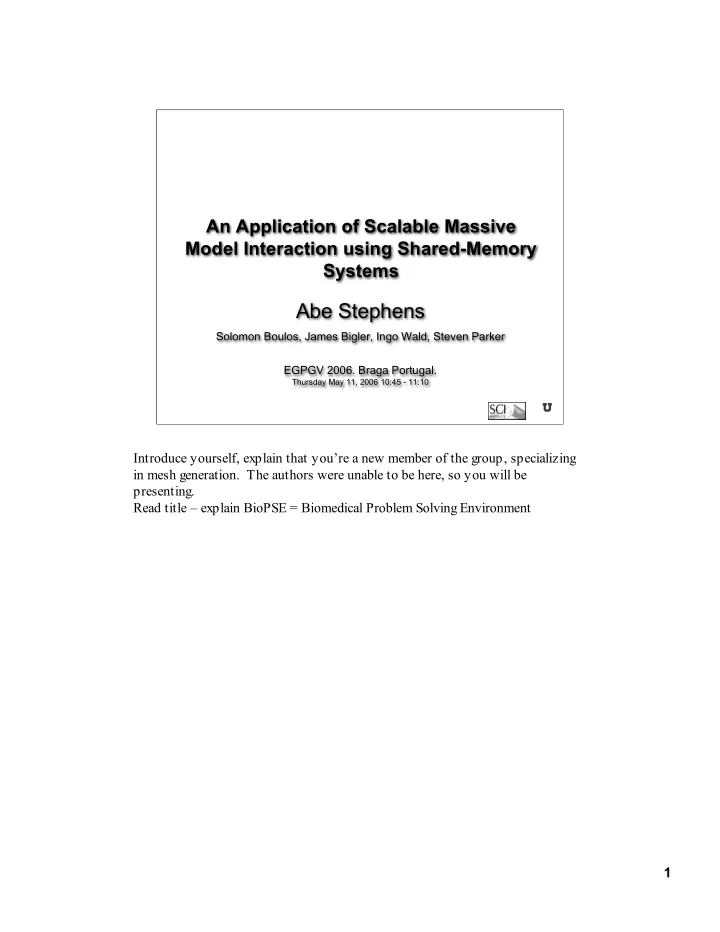

An Application of Scalable Massive Model Interaction using Shared-Memory Systems Abe Stephens Solomon Boulos, James Bigler, Ingo Wald, Steven Parker EGPGV 2006. Braga Portugal. Thursday May 11, 2006 10:45 - 11:10 Introduce yourself, explain that you’re a new member of the group, specializing in mesh generation. The authors were unable to be here, so you will be presenting. Read title – explain BioPSE = Biomedical Problem Solving Environment 1
Talk Overview Feasibility Demonstration: • Task adopted from real process. • Rendering one component. • System demonstrated at SC2005. Software Architecture: • Shared Memory Interactive Ray Tracer. • Modular, extensible design. • Transparency and ambient occlusion. Scientific Computing and Imaging Institute, University of Utah 2
Feasibility Demonstration Engineering Task 1. Quality Analyst identifies problem with aircraft (in the field). 2. Contacts Liaison Engineer, begins remote collaborative session. 3. Use 3D model to visualize problem. 4. Discuss best course of action using video and desktop sharing tools. Remote Visualization • Necessary to share large servers. • Increases data security. • Collaborative visualization a byproduct. • Performance and resolution factor of distance. Scientific Computing and Imaging Institute, University of Utah 3
Massive Model Rendering Boeing 777-200 Aircraft • ~350 M Triangles. Why Ray Trace? • sub-linear scaling in # triangles. • Easy transparency, global effects. Acceleration Structure • kd-tree acceleration structure. • Size and quality depend on build time. • Memory use not a concern. • 29 GB kd-tree. Boeing 777-200 model provided by The Boeing Company Scientific Computing and Imaging Institute, University of Utah 4
Manta Software Architecture Manta Pipeline • Display followed by rendering. • Modular and extensible components. • Transaction state changes applied each stage. • Barrier synchronization between stages. Rendering Stack • Modular call stack invoked by rendering stage. • Scene intersection and shading performed by Renderer component. Modular Design • Allows Manta to be embedded in other programs. • Supports multiple primitives: • Massive triangle models. • Massive volumes. • Sphere glyph (MPM) rendering. MIT Licensed, Open Source Software. Scientific Computing and Imaging Institute, University of Utah 5
Transparency kd-tree traversal modified • Continues until ray attenuates. • Intersections are stored in an array. • Array is sorted and each intersection color blended. Simplifications: • No solid objects, blend surfaces only. • Fixed number of intersections for constant alpha. Transparent rendering reveals intricate details while preserving the context of the model. Scientific Computing and Imaging Institute, University of Utah 6
Ambient Occlusion Adapted Instant Global Illumination • Interleaved sampling of secondary rays based on NxN pixel neighborhood. • Filter truncates based on distance threshold. • Sensitive to normal between neighbors. Compute Weights Filter Filter Kernel based on dot product between normals. Scientific Computing and Imaging Institute, University of Utah 7
Exploring the Model Object Hiding & Cutting Planes Users employed cutting planes and object hiding to locate a certain region of the Hiding Objects model, then adjusted opacity to examine fine details and occluded structures. Cutting Planes Scientific Computing and Imaging Institute, University of Utah 8
Rendering Performance 128 p 1.6 Ghz Itanium2 • 92% linear at 64p 82% at 126p • Resolution 1024x768 • Demonstration system 62 p 1.4 Ghz Itanium2 • Resolution 800x600 Scientific Computing and Imaging Institute, University of Utah 9
Rendering Performance Cont’d Ambient Occlusion 62 p 1.5 Ghz • Resolution 512x512 • 3-5 fps depending on quality. • Not fast enough to be useful during feasibility demonstration. Scientific Computing and Imaging Institute, University of Utah 10
Acknowledgments David Kasik and Jim Troy of Boeing Hansong Zhang of Silicon Graphics Inc. Rocky Rhodes, Kenny Hoff, Dan McLachlan, Jimmy Wang and other members of the now defunct Visual Systems Group at SGI. All 3D model data was provided by the Boeing Company. Manta is open source software and contains contributions from many individuals. SGI has been, and continues to be, a principle contributor. Funding Agencies • DOE ASC CSAFE • Utah Center of Excellence for Interactive Ray-Tracing and Photo Realistic Visualization Feasibility Demonstration was a joint project between: • Silicon Graphics Inc. • Intel Corporation • The Boeing Company Scientific Computing and Imaging Institute, University of Utah 11
Questions? Questions? Scientific Computing and Imaging Institute, University of Utah 12
Recommend
More recommend